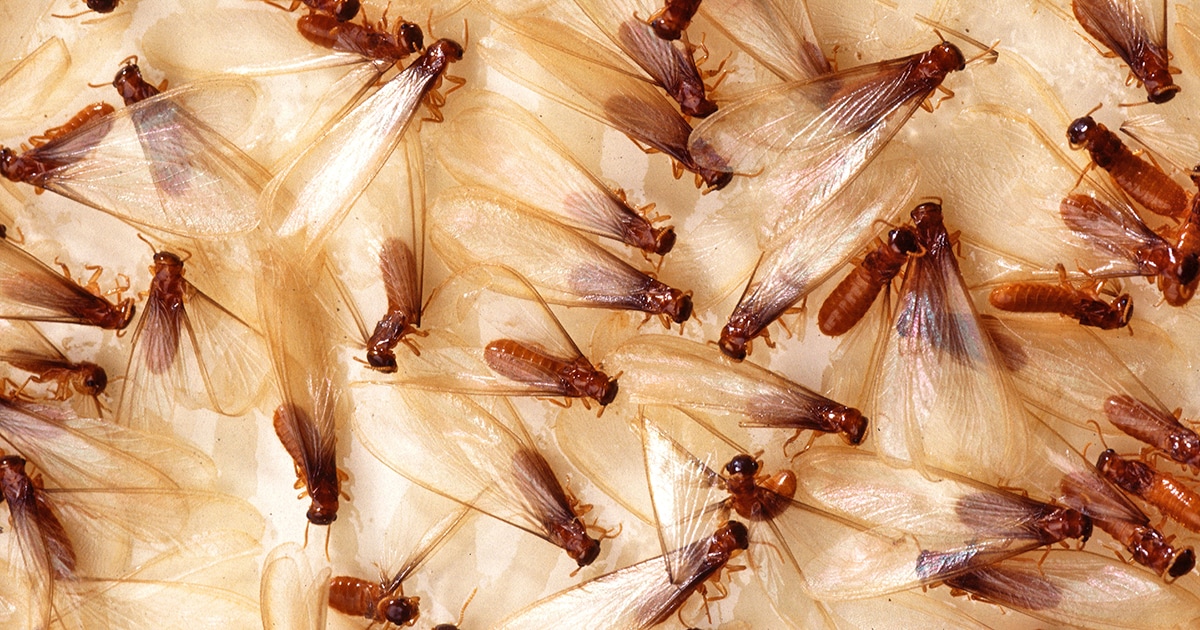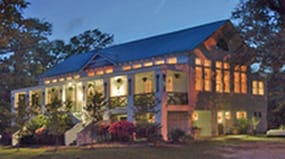God's Perfect Creatures
The Gulf Coast's on-going battle with Formosan termites will have us swatting the swarmers this May as the over-achieving insects scout out more trees, homes - and boats - to devour.
- story by Ellis Anderson
We know this single termite is a harbinger of doom. It represents the hundreds of millions of Formosan termites swarming at this very hour, in New Orleans and all across the Gulf Coast - from Tallahassee to Galveston – as if they’re being telepathically driven by an evil overlord.
We also understand that if this intrepid explorer is lucky enough to land near anything made of wood (like our conference table) and meets a fellow Formosan of the opposite sex, the pair will become the Adam and Eve of a new colony.
Post-traumatic stress triggers a deep dismay when I sight the intruder in our classroom. Fifteen years ago, the invasive insects destroyed my cherished sailboat, Wind Dancer, even though it was made from fiberglass. The termite lands on the shoulder of the woman sitting next to me at the table. While flying, Formosans are drawn to light, but when they land, they instinctively seek out dark places. They’re especially drawn to cleavages. The woman interrupts the creature’s trek by brushing it off her shoulder, her face crinkling in disgust. “Ewwwww!” The termite lands on the notebook in front of her. Sensing cellulose, it scrambles across the paper in what I imagine is joy. I’m holding a printout of the essay our class has been discussing. I reach over and use it to thwack the termite, efficiently dispatching it. Brushing the little corpse to the floor gives me some satisfaction, although true revenge will never be possible. In addition to my boat, these creatures devoured part of the historic French Quarter building where I lived for years (and thankfully didn’t own). And in fall 2015, after the Shoofly published an article explaining that Formosans are the only termites that will attack a living tree, I scheduled an inspection of the three centuries-old live oaks in our Bay St. Louis yard. Just to be safe. While New Orleans has been a hotbed of Formosan activity for decades, with each passing year the annual May swarmings on the Mississippi coast have been growing thicker and occurring on more days. When our local exterminator Dave Mayley revealed the camouflaged tunnels Formosans had built as highways to run up and down the stout trunks of my trees, I wailed. Dave understood my anguish. Sixteen years before, he’d exterminated the colony on my 24' boat - too late to save it. I never suspected Wind Dancer was home to an infestation, until one afternoon when I hopped aboard to read a book. I hadn’t been sailing lately and intended to enjoy a sunset cruise at the dock. The sun beat down more fiercely than I’d expected, so I ducked into the cabin and retrieved a rolled-up tarp. I opened it up on the deck, then stretched it across the mainsail’s boom, tying it in place to create a makeshift roof. Lounging in the shade, I had poured a glass of wine and found my place in the book when a bug landed my bare shoulder. I didn’t even look. I flicked it off. Then another one softly hit. It wriggled toward my bathing suit top. Years of fighting spring swarms in New Orleans had given my body an instinctive sense of revulsion. The wretched sensation finally registered. My attention riveted away from the book. I caught the soft squirming creature between my fingers, careful not to crush it. Recognizing the little worm with legs, my stomach wrenched. Then termites began raining on me. I’d interrupted the meal they were making of the tarp’s slender wood struts. Adrenaline surged. Leaping back down into the cabin, I grabbed a screwdriver and began tapping on surfaces. The boat’s radio was mounted into a wood panel. My screwdriver proved the bulkhead was hollow and the radio was now supported only by thick coats of paint. The termites had cunningly eaten all the wood inside the panel, but left the surface unmarred. They’d done the same through the length of the vessel. My screwdriver pierced every other piece of wood on the boat, including the mast support. I shuddered. If the boat had been caught out in a storm in recent months, the mast would certainly have fallen under the stress of the sails. Casualties would have been certain, perhaps deaths. When I called Dave Mayley and he initially inspected the boat, he insisted the infestation wasn’t my fault. There’s no way I could have known. Formosans are the only termite that doesn't need contact with the ground for a water supply. They can live off any water source - condensation in an attic, a slow-leaking pipe, or even a little briny moisture in a boat’s bilge. He also told me they can exude an acid that will eat through metal. Chemical barriers aren’t much good either. Formosans will sacrifice thousands of kamikaze soldiers to eat a path through poison. Dave and I tore apart my boat looking for what he called the “carton,” the colony headquarters. Wind Dancer was only 24 feet long, so the search should have been simple. It took us hours.
The Formosans had picked the most inaccessible place on the boat, one I didn’t even know existed, one that would have been a smuggler’s dream. Beneath the v-berth in the bow was a compartment for storage. Its front wall apparently served as the back wall for the locker in the very front, used to store the anchor and its chain. But there were actually two short walls, with an inaccessible space in between. The Formosans were sandwiched between them.
Since the boat was a total loss anyway, Dave broke apart the bulkhead to pull the carton out. He bagged the nest with gloved hands and carried it out on deck. In the sunlight, he held it up above the black garbage bag. We marveled at its intricate honeycombed construction, built from digested boat parts and dirt they must have scavenged, brought aboard by shoe soles. Dave broke off a piece of the carton and exposed white, wiggling workers. He poked at the little worms that had caused so much woe. “It’s the only place on the boat they wouldn’t have been discovered,” I said. “How did they know to pick that exact spot?” “We humans think we’re so smart,” Dave said. “But we got nothing on Formosans. These little guys? They’re God’s perfect creatures. I almost hate killing them.” In 2001, I donated Wind Dancer to a non-profit that vowed they'd try to rebuild her. Seeking some closure, I started writing a cautionary article to alert other unsuspecting boat owners. While researching, I snagged a phone interview with Ed Bordes, the Formosan expert who then headed up the New Orleans termite control board. When I told him about my boat, Bordes wasn’t impressed. In New Orleans, they’d actually discovered one colony living on a working fire truck. Each time the fire truck raced through town, lights flashing, sirens blaring, thousands of termite stowaways went along for the ride. Apparently, having an actively mobile host didn't phase the pests. Their food supply? The truck’s wooden shelves. I never finished the article about Formosans. Feature stories like that usually present a problem and then suggest solutions. The more I researched, the more I became convinced that humans are permanently on the losing side of this entomological equation. My story about the termites sank into a deep bog of negativity, with no life-ring of hope in sight. These days, I’m feeling more optimistic. My two live oaks seem to be thriving, a year after their termite treatment. Dave’s crew drilled holes into the grizzled trunks and injected a poison that’s supposed to kill Formosans without harming the trees. While poison isn’t a viable long-term solution, I choose to believe nature will eventually regulate the beasties. Even God’s most perfect creature must have an Achilles’ Heel. Some fatal flaw or unexpected enemy will thin their ranks before they eat our cities and our forests.
In the meantime, on swarming nights, I’ll turn off every light in the house. And like millions of my own inferior species spread across the Gulf South, I’ll cower in the dark, flyswatter by my side.
Comments are closed.
|
Categories
All
Archives
July 2024
|
Shoofly Magazine Partners
Our Shoofly Partners are local businesses and organizations who share our mission to enrich community life in Bay St. Louis, Waveland, Diamondhead and Pass Christian. These are limited in number to maximize visibility. Email us now to become a Shoofly Partner!




























 RSS Feed
RSS Feed























